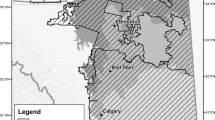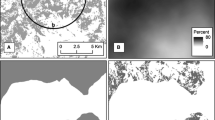Abstract
Context
The greater Everglades region in Florida (USA) is an area of wetlands that has been altered and reduced to 50% of its original area and faces multiple threats. Spatial landscape analysis can help guide a large and complex ecosystem restoration process, involving billions of dollars and multiple groups of stakeholders.
Objectives
To guide Everglades restoration efforts, we evaluated ecological performance of different hydrologic restoration scenarios using a novel technique, the structural similarity index (SSIM), which quantitatively compares similarity between pairs of gridded maps in terms of mean, variance, and covariance.
Methods
Using the SSIM, we evaluated system-wide performance of apple snails, American alligators, Great egrets, and long- and short-hydroperiod vegetation types under multiple restoration scenarios that varied in water management strategies, amounts of water storage, removal of levees and canals (decompartmentalization), and seepage control barriers. We then compared species and habitat responses under each restoration scenario to a target scenario simulating the historical, natural system.
Results
The SSIM approach provides a reliable means of scenario comparison, accounting for both the local magnitude and spatial structure of the underlying data. Our results demonstrated that decompartmentalization benefits the indicator species. In general, scenarios with increased water storage were closer to the target scenario.
Conclusions
This spatial comparison technique is useful for evaluating restoration efforts at multiple spatial scales, ranging from the entire ecosystem down to individual compartments or sub-compartments. The results can be used to inform management and restoration efforts and to guide policy for the greater Everglades area.







Similar content being viewed by others
References
Beerens JM, Frederick PC, Noonburg EG, Gawlik DE (2015) Determining habitat quality for species that demonstrate dynamic habitat selection. Ecol Evol 5:5685–5697
Beerens JM, Trexler JC, Catano CP (2017) Predicting wading bird and aquatic faunal responses to ecosystem restoration scenarios. Restor Ecol 25:S86–S98
Bennetts RE, Collopy MW, Rodgers JA (1994) The snail kite in the Florida Everglades: a food specialist in a changing environment. Everglades: the ecosystem and its restoration. St. Lucie Press, Delray Beach, Fl
Borkhataria R, Childers DL, Davis SE, Victor E, Gaiser E, Harvey J, Lodge TE, Miralles-Wilhelm F, Naja GM, Osborne T, Rivero RG, Ross MS, Trexler J, Van Lent T, Wetzel PR (2011) Synthesis of Everglades research and ecosystem services. Everglades Foundation, Palmetto Bay, Fl
Brandt LA, Beauchamp JS, Jeffery BM, Cherkiss MS, Mazzotti FJ (2016) Fluctuating water depths affect American alligator (Alligator mississippiensis) body condition in the Everglades, Florida, USA. Ecol Indic 67:441–450
Campbell MR, Mazzotti FJ (2004) Characterization of natural and artificial alligator holes. Southeast Nat 3:583–594
Darby PC, Bennetts RE, Percival HF (2008) Dry down impacts on apple snail (Pomacea paludosa) demography: implications for wetland water management. Wetlands 28:204–214
Darby PC, DeAngelis DL, Romañach SS, Suir K, Bridevaux J (2015) Modeling apple snail population dynamics on the Everglades landscape. Landscape Ecol 30:1497–1510
Davis SM, Gunderson LH, Park WA, Richardson JR, Mattson JE (1994) Landscape dimension, composition, and function in a changing Everglades ecosystem. Everglades: the ecosystem and its restoration. Delray Beach, Fl, pp 419–444
Doren RF, Trexler JC, Gottlieb AD, Harwell MC (2009) Ecological indicators for system-wide assessment of the greater everglades ecosystem restoration program. Ecol Indic 9:S2–S16
Gawlik DE (2002) The effects of prey availability on the numerical response of wading birds. Ecol Monogr 72:329–346
Jones EL, Rendell L, Pirotta E, Long JA (2016) Novel application of a quantitative spatial comparison tool to species distribution data. Ecol Indic 70:67–76
Kushlan JA, Kushlan MS (1980) Everglades alligator nests: nesting sites for marsh reptiles. Copeia 1980:930–932
Levine RS, Yorita KL, Walsh MC, Reynolds MG (2009) A method for statistically comparing spatial distribution maps. Int J Health Geogr 8:7
Lodge TE (2010) The Everglades handbook: understanding the ecosystem, 3rd edn. CRC Press-Taylor & Francis Group, Boca Raton, Fl
Long J, Robertson C (2018) Comparing spatial patterns. Geogr. Compass 12:e12356
Martin J, Kitchens WM, Cattau CE, Oli MK (2008) Relative importance of natural disturbances and habitat degradation on snail kite population dynamics. Endanger Species Res 6:25–39
Mazzotti FJ, Brandt LA (1994) Ecology of the American alligator in a seasonally fluctuating environment. Everglades: the ecosystem and its restoration. St. Lucie Press, Boca Raton, pp 485–505
Metzger JP, Esler K, Krug C, Arias M, Tambosi L, Crouzeilles R, Acosta AL, Brancalion PH, D’Albertas F, Duarte GT, Garcia LC (2017) Best practice for the use of scenarios for restoration planning. Curr Opin Environ Sustain 29:14–25
Mitsch WJ, Gosselink JG (2015) Wetlands of the world, 5th edn. Wiley, Hoboken, New Jersey
Moreno-Mateos D, Power ME, Comín FA, Yockteng R (2012) Structural and functional loss in restored wetland ecosystems. PLoS Biol 10:e1001247
NAS Committee on Restoration of Aquatic Ecosystems: Science, Technology, and Public Policy (1992) Restoration of Aquatic Ecosystems: Science, Technology and Public Policy. National Research Council
NAS Committee on Restoration of the Greater Everglades Ecosystem, (2003) Adaptive monitoring and assessment for the comprehensive Everglades restoration plan. National Academies Press, Washington D. C
National Research Council (2018) Progress toward restoring the Everglades: the seventh biennial review, 2018. The National Academies Press, Washington D. C
Novitzki RP, Smith RD, Fretwell (1996) Restoration, creation, and recovery of wetlands: wetland functions, values, and assessment
Ogden JC (1994) A comparison of wading bird nesting colony dynamics (1931–1946 and 1974–1989) as an indication of ecosystem conditions in the southern Everglades. Everglades: the ecosystem and its restoration. St. Lucie Press, Delray Beach, Fl, pp 533–570
Oteros-Rozas E, Ravera F, Palomo I (2015) Participatory scenario planning in place-based social-ecological research: insights and experiences from 23 case studies. Ecol Soc 20:32
Paudel R, Van Lent T, Wiederholt R (2019) Predicting the Everglades ecosystem response to changes in key hydrologic restoration components
Pearlstine L, Friedman S, Supernaw M (2011) Everglades landscape vegetation succession model (ELVeS) Ecological and Design Document: Freshwater Marsh & Prairie Component version 1.1. Everglades National Park, National Park Service, Homestead, Florida
Pearlstine LG, Pearlstine EV, Aumen NG (2010) A review of the ecological consequences and management implications of climate change for the Everglades. J North Am Benthol Soc 29:1510–1526
Peterson GD, Cumming GS, Carpenter SR (2003) Scenario planning: a tool for conservation in an uncertain world. Conserv Biol 17:358–366
Robertson C, Long JA, Nathoo FS, Nelson TA, Plouffe CC (2014) Assessing quality of spatial models using the structural similarity index and posterior predictive checks. Geogr Anal 46:53–74
Rutchey K, Schall TN, Doren RF, Atkinson A, Ross MS, Jones DT, Madden M, Vilchek L, Bradley KA, Snyder JR, Burch JN (2006) Vegetation classification for South Florida natural areas. US Geological Survey St, Petersburg, FL
Sequeira AM, Bouchet PJ, Yates KL, Mengersen K, Caley MJ (2018) Transferring biodiversity models for conservation: opportunities and challenges. Methods Ecol Evol 9:1250–1264
Shinde D, Pearlstine LG, Brandt LA, Mazzotti FJ, Parry MW, Jeffery BM, LoGalbo A (2014) Alligator production suitability index model (GATOR—PSIM v. 2.0): ecological and design documentation. South Florida Natural Resources Center, Everglades National Park, Homestead, Florida
Sklar FH, Chimney MJ, Newman S, McCormick P, Gawlik D, Miao S, McVoy C, Said W, Newman J, Coronado C, Crozier G (2005) The ecological–societal underpinnings of Everglades restoration. Front Ecol Environ 3:161–169
South Florida Water Management District, (2006) Natural system model (NSM). West Palm Beach, Florida
Sykes Jr PW, Rodgers Jr JA, Bennetts RE (1995) Snail kite (Rostrhamus sociabilis). The birds of North America. The Academy of Natural Sciences and the American Ornithologists’ Union No 171, Philadelphia
Tobler WR (1965) Computation of the correspondence of geographical patterns. Pap Reg Sci Assoc 15:131–139
U.S. Army Corps of Engineers and South Florida Water Management District (1999) Central and Southern Florida project comprehensive review study, final integrated feasibility report and programmatic environmental impact statement. Jacksonville and West Palm Beach, FL
Wang Z, Bovik AC, Sheikh HR, Simoncelli EP (2004) Image quality assessment: from error visibility to structural similarity. IEEE Trans Image Process 13:600–612
Wetzel PR, Davis SE, van Lent T, Davis SM, Henriquez H (2017) Science synthesis for management as a way to advance ecosystem restoration: evaluation of restoration scenarios for the Florida Everglades. Restor Ecol 25:S4–S17
Yee L (2018) Binned relative environmental change indicator (BRECI): a tool to communicate the nature of differences between environmental niche model outputs. Wilfrid Laurier University, Masters
Zulian G, Stange E, Woods H, Carvalho L, Dick J, Andrews C, Baró F, Vizcaino P, Barton DN, Nowel M, Rusch GM, Autunes P, Fernandes J, Ferraz D, Ferreira dos Santos R, Aszalós R, Arany I, Czúcz B, Priess J, Hoyer C, Bürger-Patricio G, Lapola D, Mederly P, Halabuk A, Bezak P, Kopperoinen L, Viinikka A (2018) Practical application of spatial ecosystem service models to aid decision support. Ecosyst Serv 29:465–480
Acknowledgements
We thank two anonymous reviewers for providing comments on this manuscript. Any use of trade, firm, or product names is for descriptive purposes only and does not imply endorsement by the U.S. Government.
Author information
Authors and Affiliations
Corresponding author
Additional information
Publisher's Note
Springer Nature remains neutral with regard to jurisdictional claims in published maps and institutional affiliations.
Electronic supplementary material
Below is the link to the electronic supplementary material.
Rights and permissions
About this article
Cite this article
Wiederholt, R., Paudel, R., Khare, Y. et al. A multi-indicator spatial similarity approach for evaluating ecological restoration scenarios. Landscape Ecol 34, 2557–2574 (2019). https://doi.org/10.1007/s10980-019-00904-w
Received:
Accepted:
Published:
Issue Date:
DOI: https://doi.org/10.1007/s10980-019-00904-w




